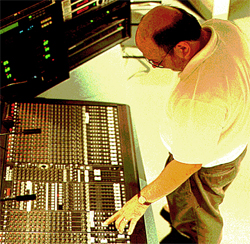
There have been many times when the players and singers decide they’re confident that they know the song and move on to the next, or decide to take a break, and I’m left there hanging, only partly done creating the sound that I was going for.
Understand that this is a two-way street. I can’t expect someone playing an electronic keyboard, for example, to play for me so I can work with the FOH sound without them being able to hear some of that keyboard sound in the monitors.
Yet I can’t properly set the gain structure for that instrument without having them play the instrument.
A question I often get asked is which do I set first, the FOH mix or the monitor mix? And the answer, of course, is both.
The problem is when the player expects the sound of the keyboard to be perfect in level and sound character from the first note. Perhaps shock therapy would work in these cases!
Building The Mix
If the worship music style includes a rhythm section or a number of instruments, then the soundcheck allows the mixer to start building the mix. Each sound tech may use a different approach to building the mix.
Personally, I like to build in blocks, working with one input at a time. In other words, I’ll start with the kick drum, then the snare, check to see how they work together, then add the rack toms and floor tom, then finally include the hi-hat and cymbals.
Then I’ll work with the bass guitar sound, check it with the kick and snare, and then check how the bass guitar and the full drum kit fit together.
Once I’m confident that I have a solid foundation upon which to build the mix, then I’ll move to the keys, guitars, other instruments, then backing vocals and finally the worship leader. My process can frustrate a worship team that wants to hear something consistent on stage during the soundcheck because I’m frequently pulling things up and down in the FOH mix as I work my way through it.
While this doesn’t affect their monitor mix, they can certainly hear the FOH changes from their location on stage, and those changes can be disconcerting.
Necessary Components
But from my perspective, the soundcheck is mine. It’s my time to use as needed. It’s the period when my needs to get the FOH mix together have to come first, and I have to be in control of how we use that time.
That may sound selfish, but it’s a necessary component if we’re going to achieve technical excellence together. Once we enter the rehearsal time, then the playing field levels out and the needs of the tech crew and the players/vocalists are equal and should be worked out together.
Another approach voiced by several seasoned sound mixers is philosophically the opposite of my approach. They prefer to keep all of the instruments and vocals up in the mix at all times so that any EQ choices or level changes can constantly be evaluated as a whole rather than individually.
That’s a tremendously valid point, and I would simply say go with what works for you. I can easily see the players and singers jumping to the defense of this second approach, since it supports their desire for more consistency during the soundcheck.
However, the reality is that neither approach will necessarily deliver a better end result than the other. On top of that, those on stage aren’t the ones mixing, and they aren’t the ones who will catch the heat if things don’t sound great, so each individual sound mixer has to use the approach of building a mix that works best for them.
I will say that I’ve found myself in recent days virtually forced by exceedingly short soundcheck times to keep the full mix up and learn how to achieve the results I’m looking for quickly and accurately without having the luxury of isolating individual parts, at least not to the degree that I’m used to doing.

